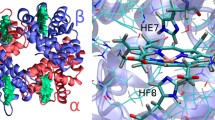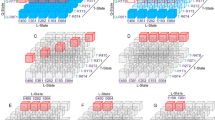Abstract
The enormous success of structural biology challenges the physical scientist. Can biophysical studies provide a truly deeper understanding of how a protein works than can be obtained from staticstructures and qualitative analysis of biochemical data? We address this question in a case study by presenting the key concepts and experimental results that have led to our current understanding of cooperative oxygen binding by hemoglobin, the paradigm of structure-function relations in multi-subunit proteins. We conclude that the underlying simplicity of the two-state allosteric mechanism could not have been demonstrated without novel physical experiments and a rigorous quantitative analysis.
Similar content being viewed by others
References
J.T. Edsall,Hemoglobin and the origins of the concept of allosterism. Federation Proceedings, 39, 1980, 226–235.
C. Bohr —K.A. Hasselbach —A. Krogh,Uber einen in biologischen Beziehung wichtigen Einfluss, den die Kohlen-sauerspannung des Blutes auf dessen Sauerstoffbindung übt. Skand. Arch. Physiol., 15, 1904, 401–412.
G.S. Adair,A critical study of the direct method of measuring osmotic pressure of hemoglobin. Proc. Roy. Soc. London Ser. A, 108A, 1925, 627–637.
L. Pauling,The oxygen equilibrium of hemoglobin and its structural interpretation. Proc. Natl. Acad. Sci. USA, 21, 1935, 186–191.
L. Pauling —H.A. Itano —S.J. Singer —I.C. Wells,Sickle cell anemia: A molecular disease. Science, 110, 1949, 543–548.
M.F. Perutz —W. Bolton —R. Diamond —H. Muirhead —H. Watson,Structure of haemoglobin. An X-ray examination of reduced horse haemoglobin. Nature, 203, 1964, 687–690.
J. Monod —J. Wyman —J.-P. Changeux,On the nature of allosteric transitions: a plausible model. J. Mol. Biol., 12, 1965, 88–118.
D.E. Koshland —G. Nemethy —D. Filmer,Comparison of experimental binding data and theoretical models in proteins containing subunits. Biochemistry, 5, 1966, 365–385.
M.F. Perutz,Stereochemistry of cooperative effects in haemoglobin. Nature, 228, 1970, 726–739.
M.F. Perutz —A.J. Wilkinson —M. Paoli —G.G. Dodson,The stereochemistry of the cooperative effects in hemoglobin revisited. Ann. Rev. Biophys. Biomol. Struct., 27, 1998, 1–34.
D. Rodgers —R.H. Crepeau —S.J. Edelstein,Pairings and polarities of the 14-strands in sickle cell hemoglobin fibers. Proc. Natl. Acad. Sci. USA, 84, 1987, 6157–6161.
W.A. Eaton —J. Hofrichter,Sickle cell hemoglobin polymerization. Adv. Prot. Chem., 40, 1990, 63–279.
S.J. Edelstein,Extensions of the allosteric model to haemoglobin. Nature, 230, 1971, 224–227.
A. Szabo —M. Karplus,A mathematical model for structure-function relations in hemoglobin. J. Mol. Biol., 72, 1972, 163–197.
K. Imai,The Monod-Wyman-Changeux allosteric model describes haemoglobin oxygenation with only one adjustable parameter. J. Mol. Biol., 167, 1983, 741–749.
R.G. Shulman —J.J. Hopfield —S. Ogawa,Allosteric interpretation of haemoglobin properties. Quart. Rev. Biophys., 8, 1975, 325–420.
M.F. Perutz,Mechanisms of cooperativity and allosteric regulation in proteins. Quart. Rev. Biophys., 22, 1989, 139–236.
F.R. Smith —G.K. Ackers,Experimental resolution of cooperative free energies for the ten ligation states of human hemoglobin. Proc. Natl. Acad. Sci. USA, 82, 1985, 5347–5351.
C.A. Sawicki —Q.H. Gibson,Quaternary conformational changes in human hemoglobin studied by laser photolysis of carboxyhemoglobin. J. Biol. Chem., 251, 1976, 1533–1542.
C. Rivetti —A. Mozzarelli —G.L. Rossi —E.R. Henry —W.A. Eaton,Oxygen binding by single crystals of hemoglobin. Biochemistry, 32, 1993, 2888–2906.
R. Liddington —Z. Derewenda —G.G. Dodson —D. Harris,Structure of the liganded T state of hemoglobin identifies the origin of cooperative oxygen binding. Nature, 331, 1988, 725–728.
D.Z.P. Sun —M. Zou —N.T. Ho —C. Ho,The contribution of surface histidyl residues in the alpha-chain to the bohr effect of human adult normal hemoglobin: roles of global electrostatic effects. Biochemistry, 36, 1997, 6663–6673.
S. Bettati —A. Mozzarelli —M.F. Perutz,Allosteric mechanism of haemoglobin: Rupture of salt-bridges raises the oxygen affinity of the T-structure. J. Mol. Biol., 281, 1998, 581–585.
N. Shibyama —S. Saigo,Fixation of the quaternary structures of human adult haemoglobin by encapsulation in transparent porous silica gels. J. Mol. Biol., 251, 1995, 203–209.
S. Bettati —A. Mozzarelli,T state hemoglobin binds oxygen noncooperatively with allosteric effects of protons, inositol hexaphosphate, and chloride. J. Biol. Chem., 272, 1997, 32050–32055.
G.K. Ackers,Deciphering the molecular code of hemoglobin allostery. Adv. Prot. Chem., 51, 1998, 185–153.
S.J. Gill —C.H. Robert —M. Coletta —E. Di Cera —M. Brunori,Cooperative free energies for nested allosteric models as applied to human hemoglobin. Biophys. Chem., 50, 1986, 747–752.
A. Mozzarelli —C. Rivetti —G.L. Rossi —W.A. Eaton —E.R. Henry,Allosteric effectors do not alter the oxygen affinity of hemoglobin crystals. Protein Science, 6, 1997, 484–489.
N. Shibayama —H. Morimoto —S. Saigo,Asymmetric cynanomet valency hybrid hemoglobin: The issue of valency exchange. Biochemistry, 37, 1998, 6221–6228.
Q.H. Gibson,The photochemical formation of a quickly reacting form of haemoglobin. Biochem. J., 71, 1959, 293–303.
E. Antonini —M. Brunori,Hemoglobin and myoglobin in their reactions with ligands. North-Holland Publishing Co., Amsterdam 1971.
J.J. Hopfield —R.G. Shulman —S. Ogawa,An allosteric model of hemoglobin: I, kinetics. J. Mol. Biol., 61, 1971, 425–443.
J. Hofrichter —J.H. Sommer —E.R. Henry —W.A. Eaton,Nanosecond absorption spectroscopy of hemoglobin, elementary processes in kinetic cooperativity. Proc. Natl. Acad. Sci. USA, 80, 1983, 2235–2239.
T.A. Jackson —M. Lim —P.A. Anfinrud,Complex nonexponential relaxation in myoglobin after photodissociation of MbCO: measurement and analysis from 2 ps to 56 µs. Chem. Phys., 180, 1994, 131–140.
H. Frauenfelder —S.G. Sligar —P.G. Wolynes,The energy landscapes and motions of proteins. Science, 254, 1991, 1598–1603.
N. Agmon —J.J. Hopfield,CO binding to heme proteins; A model for barrier height distributions and slow conformational changes. J. Chem. Phys., 79, 1983, 2042–2053.
S.J. Hagen —J. Hofrichter —W.A. Eaton,Protein reaction kinetics in a room-temperature glass. Science, 269, 1996, 959–962.
R.H. Austin —K.W. Beeson —L. Eisenstein —H. Frauenfelder —I.C. Gunsalus,Dynamics of ligand binding to myoglobin. Biochemistry, 14, 1975, 5355–5373.
W.A. Eaton —E.R. Henry —J. Hofrichter,Application of linear free energy relations to protein conformational changes: the quaternary structural change of hemoglobin. Proc. Natl. Acad. Sci. USA, 88, 1991, 4472–4475.
E.R. Henry —C.M. Jones —J. Hofrichter —W.A. Eaton,Can a two-state MWC allosteric model explain hemoglobin kinetics? Biochemistry, 36, 1997, 6511–6528.
M. Perrella —A. Colosimo —L. Benazzi —M. Ripamonti —L. Rossi-Bernardi,What the intermediate compounds in ligand binding to hemoglobin tell about the mechanism of cooperativity. Biophys. Chem., 37, 1990, 211–223.
R.E. Dickerson —I. Geis,Hemoglobin: Structure, Function, Evolution, and Pathology. Benjamin/Cummings Pub. Co., Menlo Park, CA, 1983.
Y.W. Huang —M.L. Doyle —G.K. Ackers,The oxygen-binding intermediates of human hemoglobin: Evaluation of their contributions to cooperativity using zinc-containing hybrids. Biophys. J., 71, 1996, 2094–2105.
M.L. Doyle —J.M. Holt —G.K. Ackers,Effects of NaCl on the linkages between O2 binding and subunit assembly in human hemoglobin: titration of the quaternary enhancement effect. Biophys. Chem., 64, 1997, 271–287.
G.K. Ackers,The energetics of ligand-linked subunit assembly in hemoglobin require a third allosteric structure. Biophys. Chem., 37, 1990, 371–382.
Author information
Authors and Affiliations
Corresponding author
Additional information
Reprinted from Nature Structural Biology, vol. 6, W.A. Eaton, E.R. Henry, J. Hofrichter, and A. Mozzarelli,Is cooperative oxygen binding by hemoglobin really understood?, pp. 351–358, Copyright (1999), with permission from Nature Publishing Group.
Rights and permissions
About this article
Cite this article
Eaton, W.A., Henry, E.R., Hofrichter, J. et al. Is cooperative oxygen binding by hemoglobin really understood?. Rend. Fis. Acc. Lincei 17, 147–162 (2006). https://doi.org/10.1007/BF02904506
Issue Date:
DOI: https://doi.org/10.1007/BF02904506




